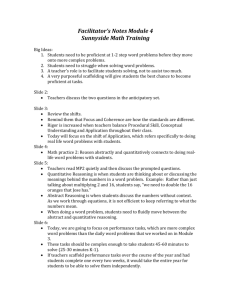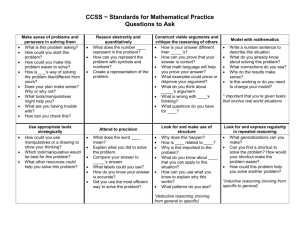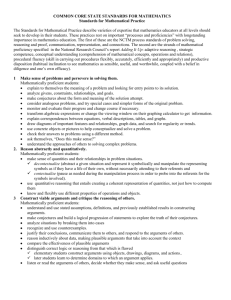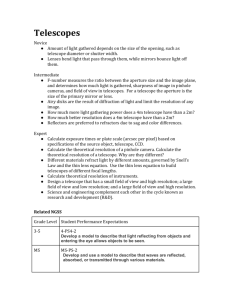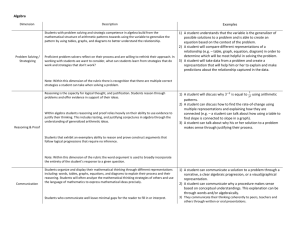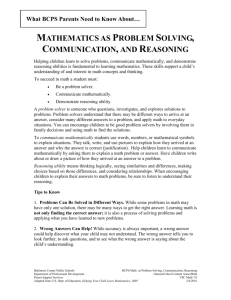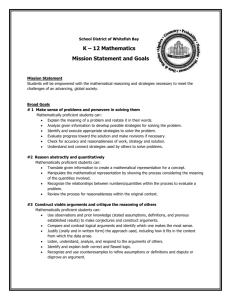CCS Standards for Mathematical Practice
advertisement
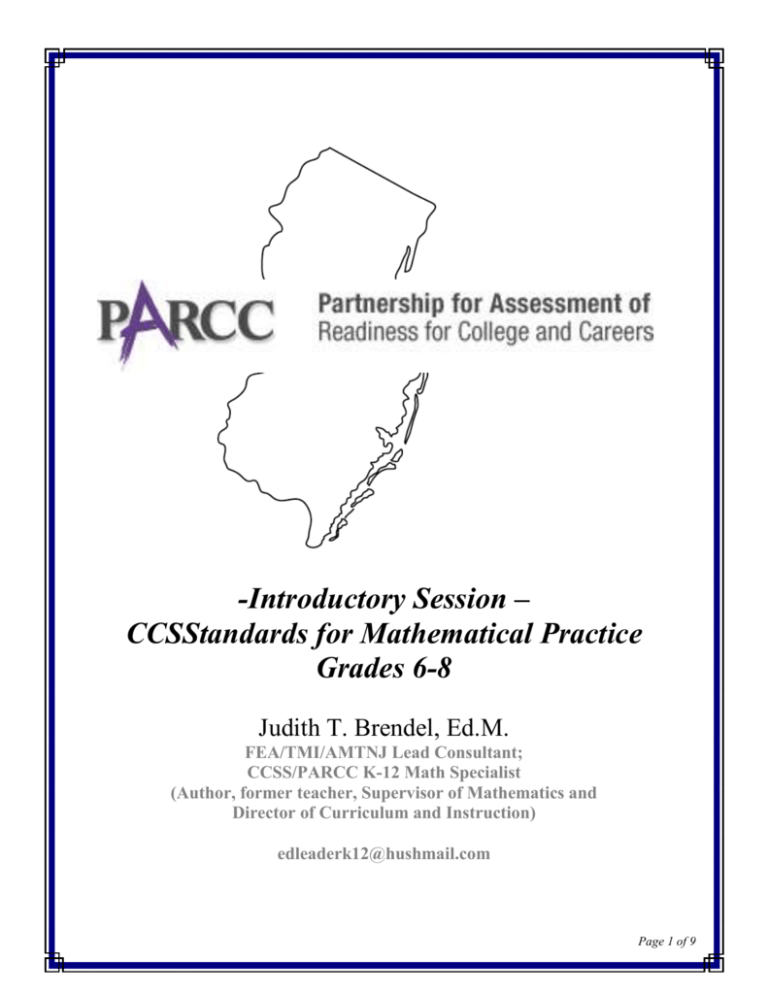
-Introductory Session – CCSStandards for Mathematical Practice Grades 6-8 Judith T. Brendel, Ed.M. FEA/TMI/AMTNJ Lead Consultant; CCSS/PARCC K-12 Math Specialist (Author, former teacher, Supervisor of Mathematics and Director of Curriculum and Instruction) edleaderk12@hushmail.com Page 1 of 9 Workshop: CCSS for MATHEMATICAL PRACTICE (forms are printed in this workbook.) Activities: 1 Cut the Cake (MP form-1, page 3) Math Practices (page 4) 2 21st.Century_Pass it On Geometry p. 9A-B (MP form-2, page 5) 21st.Century_Pass it On Trip to the Zoo p.9C-E (MP form-2, page 5) 3 4 How Do I Get to School? (form-3 NCTM PBL activities, page 6) How Do You Spend Saturday? (form-3 NCTM PBL activities, page 6) Other NCTM Illuminations task as selected. 5 6 7 Scrambled Comics (MP form-2, page 5) Map and Trip (MP form-2, page 5) As the Crow Flies: from NCTM (MP form-2, page 5) 8 Ski Indoors: from IDE (MP form-3, page 5) Run Forest Run: from M. Gaeta (MP use form-3, page 5 9 10 Grades 3-8: EngageNY (online) (MP form-4, page 7) Algebra: Dana Center_Type I, II, III tasks (Online) (MP form-4, page 7) 11 Online Resources 12 Action Planning: Next Steps (Form-5, page 8) 13 Reflection/ feedback (Form-6 Last page in workbook, page 9) Activity worksheets will be distributed separately. Judith T. Brendel 2015-2016 Page 2 of 9 FORM-1 Process Standards (2008 CCCS) Math Practices (2010 CCSS) 1. Problem Solving 1. Make sense of problems & persevere in solving them. 2. Reasoning and Proof 2. Reason abstractly and quantitatively. 3. Communication 3. Construct viable arguments and critique the reasoning of others. 4. Connections 4. Model with mathematics 5. Representation 5. Use appropriate tools strategically. CUT-THE-CAKE activity Where did you have this experience in the Cut-the-Cake activity? 6. Attend to precision 7. Look for and make use of structure 8. Look for and express regularity in repeated reasoning. Page 3 of 9 CCSS STANDARDS for MATHEMATICAL PRACTICE (partial descriptions) 1. Make sense of problems and persevere in solving them. “Mathematically proficient students start by explaining to themselves the meaning of a problem and looking for entry points to its solution. They analyze givens, constraints, relationships, and goals. They make conjectures about the form and meaning of the solution and plan a solution pathway rather than simply jumping into a solution attempt….” 2. Reason abstractly and quantitatively. “Mathematically proficient students make sense of quantities and their relationships in problem situations. … Quantitative reasoning entails habits of creating a coherent representation of the problem ….” 3. Construct viable arguments and critique the reasoning of others. “Mathematically proficient students understand and use stated assumptions, definitions, and previously established results in constructing arguments. … They are able to analyze situations by breaking them into cases, and can recognize and use counterexamples….” 4. Model with mathematics. “Mathematically proficient students can apply the mathematics they know to solve problems arising in everyday life, society and the workplace…..” 5. Use appropriate tools strategically. “Mathematically proficient students consider the available tools when solving a mathematical problem. … Mathematically proficient students are sufficiently familiar with tools appropriate for their grade or course to make sound decisions about when each of these tools might be helpful, ….” 6. Attend to precision. “Mathematically proficient students try to communicate precisely to others. They try to use clear definitions in discussions with others and in their own reasoning. … They are careful about specifying units of measure, and labeling axes ….” 7. Look for and make use of structure. “Mathematically proficient students look closely to discern a pattern or structure. Young students, for example, might notice that three and seven more is the same amount as seven and three more, …. Later, students … can see complicated things, such as some algebraic expression, as single objects or as being composed of several objects. …” 8. Look for and express regularity in repeated reasoning “Mathematically proficient students notice if calculations are repeated, and look for general methods and for shortcuts. Upper elementary students might notice when dividing 25 by 11 that they are repeating the same calculations over and over again, and conclude they have a repeating decimal. … As they work to solve a problem, mathematically proficient students maintain oversight of the process, while attending to the details. They continually evaluate the reasonableness of their intermediate results….” Link for full descriptions. http://www.corestandards.org/Math/Practice/ Page 4 of 9 FORM-2 MP1- Make sense of problems and persevered in solving them MP-2 Reason abstractly and quantitatively MP-3 Construct viable arguments and critiques the reasoning of others MP-4 Model with mathematics ACTIVITY 1-2 MPs MP-5 Use appropriate tools strategically MP-6 Attend to precision MP-7 Look for and make sense of structure MP-8 Look for & express regularity in repeated reasoning Explanation/Justification 21st Century Assembly Line or PASS-IT –ON (Geometry) 21st Century Assembly Line or PASS-IT –ON (Trip to the Zoo) Scrambled Comics Map and Trip As the Crow Flies Ski Indoors (Grade 8, Algebra) Run Forest Run (Grade 8, Algebra) Page 5 of 9 FORM-3 PROBLEM-BASED LEARNING ACTIVITIES (NCTM Illuminations) MP1- Make sense of problems and persevere in solving them MP-2 Reason abstractly and quantitatively MP-3 Construct viable arguments and critique the reasoning of others MP-4 Model with mathematics Task MP MP-5 Use appropriate tools strategically MP-6 Attend to precision MP-7 Look for and make sense of structure MP-8 Look for & express regularity in repeated reasoning Describe Task and Explain how it assesses MP How Do We Get to School? How Do You Spend Saturday? Sports Numbers Squares and Parallelograms Rolling Dice Cranberry Punch Hay Bale Famer Page 6 of 9 FORM-4 ONLINE: Grades 3-8: EngageNY* or Grade 3-HS: Dana Center Toolbox, PARCC I, II, II tasks or Grade 3-HS: Interactive PARCC EOY Test MP1- Make sense of problems and persevere in solving them MP-2 Reason abstractly and quantitatively MP-3 Construct viable arguments and critiques the reasoning of others MP-4 Model with mathematics Grade/Course Task/year* MP MP-5 Use appropriate tools strategically MP-6 Attend to precision MP-7 Look for and make sense of structure MP-8 Look for & express regularity in repeated reasoning Experience task, then Describe Task and Explain how it assesses MP Page 7 of 9 Form-5: Activity-Action Planning/Next Steps: Carefully consider where you are now regarding CCSS and Math-Practices related implementation. Then, complete the exercise below. Goals Action Items Targeted Dates Evidence of Progress and Impact Page 8 of 9 Form-6: Your FEEDBACK is graciously accepted and much appreciated. Today’s Workshop: An Introduction to the CCSS Practices of Mathematical Standards Your grade-level: _______ The three most useful things I learned today: Two things I would share with a colleague: One question that I have: Page 9 of 9

